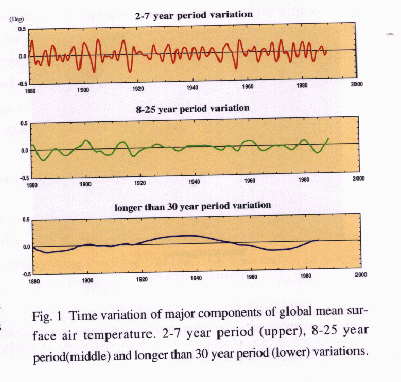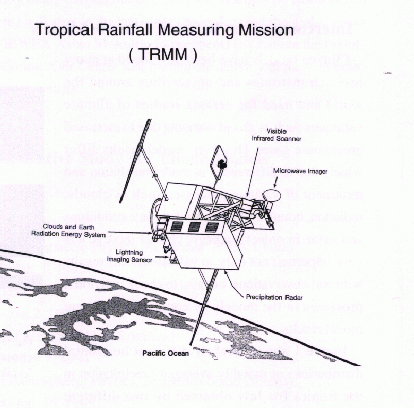 Climate Analysis
Climate Analysis Climate Analysis
Climate AnalysisThe Climate Analysis Section aims to analyze spatial and temporal structures of the climate system using long term records of surface, upper-air, ocean and satellite observations over the globe and to understand the processes of interaction between atmosphere and ocean and land surfaces. The main causes and mechanisms of unusual weather occurring in the world are also investigated. These observational results are compared with model output to validate and improve the climate models.
 Research subjects
Research subjects Understanding of Climate Variability
Understanding of Climate Variability
It has been reported that the global mean surface air temperature has increased by about 0.5°C over the last 100 years which is thought to be due to the enhancement of greenhouse gas effects such as carbon dioxide. However, the surface air temperature also includes natural variability with periods of years and decades. Figure 1 shows three components of the variation of global mean surface air temperature with periods of 2-7 years,8-25 years and longer than 30 years, respectively, which are obtained by applying band-pass filters. The components all have amplitudes of about 0.4-0.6°C. Among the three components the 2-7 year period variation is known to be affected by ENSO (El Nino and Southern Oscillation), but the mechanism of the other longer period variations has not been understood. It may be very important to examine the features and mechanisms of these interdecadal variations for the detection of the global warming.
 Investigation of Causes of Unusual Weathers
Investigation of Causes of Unusual Weathers
Japan experienced an unusually cool summer in 1993 after an interval of about 40 years. The mean temperature over northern and eastern Japan was about 2°C lower than normal. Agricultural products such as rice were severely damaged due to this cool summer climate. Figure 2 shows the surface weather map and the jet stream at about 5km height (red lines). Based on the analysis of the surface and upper air observations it can be understood that the extremely cool summer in 1993 may have resulted from (1) the Pacific High being very weak and (2) the Ohotsk High being stationed for a long period throughout the summer season to the north of Hokkaido. Recent studies indicate that the strength of the Pacific High is related to interannual variations of tropical convection and the sea surface temperature. The long duration of the Ohotsk High seems to be linked to the dominance of the blocking phenomena to the north of the Japan islands. In the Climate Analysis Section we intend to pinpoint the major causes of unusual weathers and investigate their mechanisms.
 Analysis of Tropical Convection by Satellite Observations
Analysis of Tropical Convection by Satellite Observations
It is known that the temporal and spatial variations of convective activity in the tropics have a significant impact on the climate in extratropical regions. However, tropics are mostly covered by oceans, and it is very difficult to detect convective activity based on the usual surface observations. Recently analyses of tropical convection using visible, infrared and microwave observations derived from satellites have been extensively developed. As a result, it has become clear that cumulus clouds in the tropics are organized into various types of convective systems with horizontal scales ranging from several tens to several thousands of kms. These convective systems behave differently on different scales. Although satellite observations so far obtain information only near the tops of clouds, it is planned to launch a new satellite called TRMM (Tropical Rainfall Measuring Mission) which includes a precipitation radar to observe tropical precipitation from space. It is hoped that more detailed knowledge of the structure inside convective systems will be obtained from TRMM.
